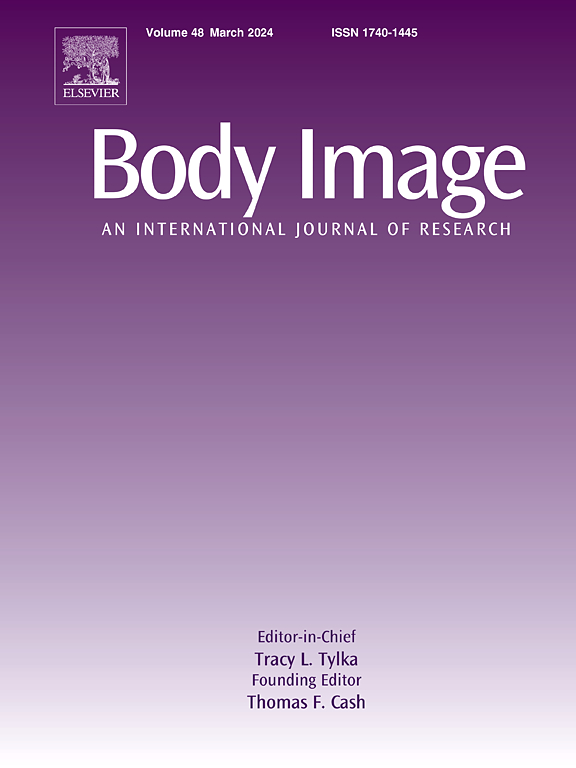“Trapped in an echo chamber of whiteness”: Exploring real-world barriers in understanding and challenging white supremacy in body image research in the global north
IF 5.4
1区 心理学
Q1 PSYCHIATRY
引用次数: 0
Abstract
There is an urgent need to decentre white-centric epistemologies and methodologies in body image research. However, systemic change will be difficult to achieve without understanding body image researchers’ perceptions of the scale of the problem and the barriers they face in disrupting white supremacy. The present study aims to: i) explore researchers’ perceived impact of white supremacy in the field, and ii) identify barriers in adopting anti-racist research practices. Forty-seven body image and appearance researchers (aged 24–57 years; M = 33.96, SD = 7.31) across career stages participated in an online survey examining their understanding of white supremacy’s influence on the field, barriers in adopting anti-racist research practices on multiple levels, and their perceived responsibility and impact. Descriptive data indicated some perceived influence of white supremacy on body image research currently (M = 2.87; SD = 2.11; range = 1–7). Participants attributed greater responsibility for addressing white supremacy to researchers who were more advanced in their career, with late-stage researchers most frequently ranked most responsible (n = 21). Participants rated their own responsibility as moderately low (M = 2.02; SD = 0.93) but their own actions as slightly impactful (M = 4.65; SD = 2.08; all ranges 1–7). Reflexive content analysis highlighted the importance in contextualising researchers’ situatedness within white-centric power structures (Category 1), characterised by homogenous white spaces and groups (Category 2), which contributed to multiple barriers within the research process (Category 3). Based on these findings, we made recommendations for targeted and practical solutions to move the field forward.
“困在白人的回音室”:探索现实世界中理解的障碍和挑战全球北方身体形象研究中的白人至上主义
在身体形象研究中,迫切需要打破以白人为中心的认识论和方法论。然而,如果不了解身体形象研究人员对问题规模的看法,以及他们在打破白人至上主义时面临的障碍,就很难实现系统性的改变。本研究旨在:i)探索研究人员对该领域白人至上主义的感知影响,ii)确定采用反种族主义研究实践的障碍。47名身体形象与外貌研究者(年龄24-57岁;M = 33.96, SD = 7.31)参与了一项在线调查,调查了他们对白人至上主义对该领域的影响的理解,在多个层面上采取反种族主义研究实践的障碍,以及他们认为的责任和影响。描述性数据表明,目前白人至上主义对身体形象研究的一些感知影响(M = 2.87;Sd = 2.11;范围= 1-7)。参与者认为,在解决白人至上问题上,处于职业生涯晚期的研究人员负有更大的责任,而处于职业生涯后期的研究人员通常被评为最负责任的(n = 21)。参与者对自己责任的评价为中等低(M = 2.02;SD = 0.93),但他们自己的行为影响较小(M = 4.65;Sd = 2.08;所有范围为1-7)。反身性内容分析强调了研究人员在以白人为中心的权力结构(第1类)中的情境化的重要性,这种权力结构的特征是同质的白人空间和群体(第2类),这导致了研究过程中的多重障碍(第3类)。基于这些发现,我们提出了有针对性和实用的解决方案,以推动该领域向前发展。
本文章由计算机程序翻译,如有差异,请以英文原文为准。
求助全文
约1分钟内获得全文
求助全文
来源期刊

Body Image
Multiple-
CiteScore
8.70
自引率
28.80%
发文量
174
期刊介绍:
Body Image is an international, peer-reviewed journal that publishes high-quality, scientific articles on body image and human physical appearance. Body Image is a multi-faceted concept that refers to persons perceptions and attitudes about their own body, particularly but not exclusively its appearance. The journal invites contributions from a broad range of disciplines-psychological science, other social and behavioral sciences, and medical and health sciences. The journal publishes original research articles, brief research reports, theoretical and review papers, and science-based practitioner reports of interest. Dissertation abstracts are also published online, and the journal gives an annual award for the best doctoral dissertation in this field.
 求助内容:
求助内容: 应助结果提醒方式:
应助结果提醒方式:


